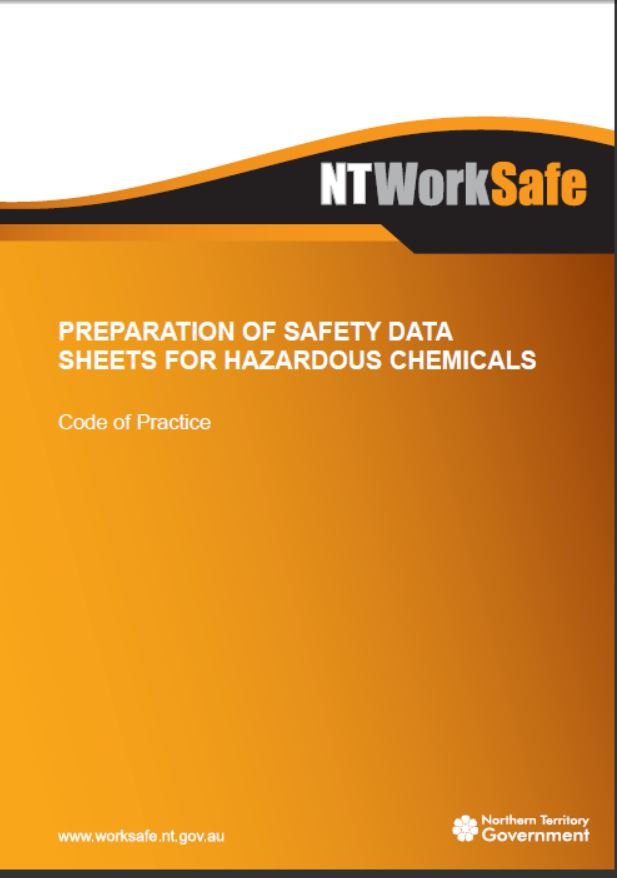This Code of Practice on Preparation of Safety Data Sheets for Hazardous Chemicals is an approved code of practice under Section 274 of the Work Health and Safety (National Uniform Legislation) Act 2011 (the WHS Act). An approved code of practice is a practical guide to achieving the standards of health, safety and welfare required under the WHS Act and the Work Health and Safety (National Uniform Legislation) Regulations 2011 (the WHS Regulations).A code of practice applies to anyone who has a duty of care in the circumstances described in the code. In most cases, following an approved code of practice would achieve compliance with the health and safety duties in the WHS Act, in relation to the subject matter of the code. Like regulations, codes of practice deal with particular issues and do not cover all hazards or risks that may arise. The health and safety duties require duty holders to consider all risks associated with work, not only those for which regulations and codes of practice exist. Codes of practice are admissible in court proceedings under the WHS Act and Regulations. Courts may regard a code of practice as evidence of what is known about a hazard, risk or control and may rely on the code in determining what is reasonably practicable in the circumstances to which the code relates. An inspector may refer to an approved code of practice when issuing an improvement or prohibition notice. This Code of Practice has been developed by Safe Work Australia as a model code of practice under the Council of Australian Governments’ Inter Governmental Agreement for Regulatory and Operational Reform in Occupational Health and Safety for adoption by the Commonwealth, state and territory governments.A draft of this Code of Practice was released for public consultation on 7 December 2010 and was endorsed by the Workplace Relations Ministers Council on 10 August 2011.
1.1 What is a safety data sheet?
A safety data sheet (SDS), previously called a Material Safety Data Sheet (MSDS), is a document that provides information on the properties of hazardous chemicals, how they affect health and safety in the workplace and on how to manage the hazardous chemicals in the workplace. For example it includes information on the identity, health and physicochemical hazards, safe handling and storage, emergency procedures and disposal considerations.
An SDS is an important tool for eliminating or minimising the risks associated with the use of hazardous chemicals in workplaces.
1.2 The meaning of key terms and abbreviations
ADG Code means the Australian Code for the Transport of Dangerous Goods by Road and Rail, 7th edition, approved by the Australian Transport Council. The ADG Code is accessible at the National Transport Commission website www.ntc.gov.au Hazardous chemical means any substance, mixture or article that satisfies the criteria for a hazard class in the Globally Harmonised System of Classification and Labeling of Chemicals (GHS) including a classification referred to in Schedule 6 of the WHS Regulations, but does not include a substance, mixture or article that satisfies the criteria solely for one of the following hazard classes:
- acute toxicity – oral – Category 5
- acute toxicity – dermal – Category 5
- acute toxicity – inhalation – Category 5
- skin corrosion/irritation – Category 3
- serious eye damage/eye irritation – Category 2B
- aspiration hazard – Category 2
- flammable gas – Category 2
- acute hazard to the aquatic environment – Category 1, 2 or 3
- chronic hazard to the aquatic environment – Categories 1, 2, 3 or 4, or
- hazardous to the ozone layer.
Further definitions and abbreviations used in this Code are listed in Appendix A.
1.3 What are the duties in relation to the preparation of safety data sheets?
Manufacturers and importers of hazardous chemicals have duties under the WHS Regulations to provide current information about the hazardous chemical in the form of an SDS. These duties are summarised below.

Table of Contents
FOREWORD 2
1. INTRODUCTION 3
1.1 What is a safety data sheet? 3
1.2 The meaning of key terms and abbreviations 3
1.3 What are the duties in relation
to the preparation of safety data sheets? 3
1.4 When is it necessary to prepare a safety data
sheet? 4
2. PREPARING, REVIEWING AND AMENDING SAFETY DATA SHEETS 6
2.1 What information is needed in an SDS? 6
2.2 Research Chemicals, Waste Products
or Samples for Analysis 8
2.3 Can an SDS prepared overseas be used? 8
2.4 Reviewing and amending an SDS 9
3. CONTENT OF THE SAFETY DATA SHEET 10
3.1 Section 1 – Identifi cation 10
3.2 Section 2 – Hazard(s) Identifi cation 11
3.3 Section 3 – Composition and Information
on Ingredients 12
3.4 Section 4 – First Aid Measures 13
3.5 Section 5 – Fire Fighting Measures 15
3.6 Section 6 – Accidental Release Measures 15
3.7 Section 7 – Handling and Storage 17
3.8 Section 8 – Exposure controls and personal
protection 18
3.9 Section 9 – Physical and Chemical Properties 20
3.10 Section 10 – Stability and Reactivity 22
3.11 Section 11 – Toxicological Information 23
3.12 Section 12 – Ecological Information 26
3.13 Section 13 – Disposal considerations 27
3.14 Section 14 – Transport Information 27
3.15 Section 15 – Regulatory Information 28
3.16 Section 16 – Other information 29
APPENDIX A – DEFINITIONS
AND ABBREVIATIONS 30
APPENDIX B – HEADER CHECKLIST 33
APPENDIX C – GHS LABEL ELEMENTS
FOR INCLUSION IN THE SDS 36
APPENDIX D – GUIDE FOR SELECTING
GENERIC NAMES 88
APPENDIX E – OTHER RELEVANT
INFORMATION 92




